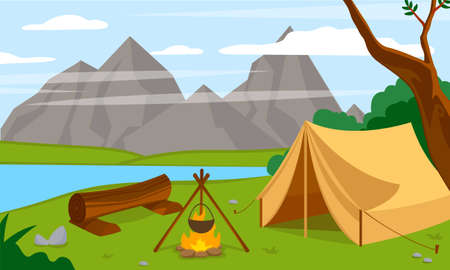1. Understanding British Weather Patterns
If you’re planning to camp anywhere in the UK, the first survival skill is understanding the local weather – and there’s no escaping it: rain is a constant companion. The British Isles are infamous for unpredictable skies, with showers appearing at a moment’s notice, even in what passes for summer. From Cornwall to the Highlands, rainfall shapes every outdoor experience. Typically, the wettest months span from October through January, but even late spring and early autumn can surprise you with heavy downpours or persistent drizzle. Coastal areas often see sudden squalls, while inland regions might suffer prolonged soaking rain. In short, when selecting a campsite, it’s vital to anticipate not only the frequency but also the intensity of rainfall. Knowing which seasons bring relentless mizzle versus short sharp showers will help you avoid waterlogged pitches and muddy misery. To outsmart the elements, always factor in regional variations and local microclimates – what’s true for Kent won’t hold in Cumbria. In this landscape, preparation isn’t just wise; it’s essential for staying dry and comfortable on your UK camping adventure.
Choosing The Right Terrain
When it comes to setting up camp in the UK, especially with our notorious rainy weather, selecting suitable terrain is crucial for both comfort and safety. The landscape here offers a variety of terrains—rolling hills, valleys, moorlands, woodlands, and riversides—all of which come with their own set of advantages and risks during wet conditions.
Terrain Types: What to Seek and What to Avoid
Understanding how different land features react to heavy rainfall will help you make an informed decision. Here’s a quick reference guide:
| Terrain Feature | Recommendation | Flood Risk | Notes |
|---|---|---|---|
| Flat Open Ground | Avoid if in depressions | High in low-lying areas | Can pool water quickly; seek slightly raised flat ground instead |
| Slopes (Gentle) | Seek (mid-slope) | Low-Moderate | Avoid bottom or top of slope; mid-slope sheds water well without runoff pooling at your pitch |
| Valleys & Dips | Avoid | Very High | Natural collection points for rainwater and prone to flash floods |
| Close to Water (Rivers/Lakes/Streams) | Avoid within 50m | Very High during rain | Water levels can rise rapidly; ground can become saturated and unstable |
| Moorland/Peaty Ground | Avoid if possible | High when wet | Poor drainage leads to boggy conditions; risk of sinking or flooding tent base |
| Sheltered Woodland Edge | Seek (with caution) | Low-Moderate | Trees can provide windbreak but avoid under dead branches; check for root systems that can channel water towards your pitch during downpour |
Selecting the Safest Spot: Practical Tips for Rainy UK Weather
- Avoid pitching at the lowest point around. Rainwater naturally flows downhill, collecting in hollows and dips.
- Select slightly elevated ground that is not exposed to strong winds.
- Stay well back from riverbanks and lakeshores. Even small streams can swell rapidly after heavy rain.
- If you must camp on a slope, position your tent perpendicular to the incline and ensure your head is uphill.
The Bottom Line: Prioritise Drainage and Safety Over Views in Wet Conditions
Your choice of terrain can mean the difference between a dry night’s sleep or waking up in a puddle. In Britain’s unpredictable climate, always assess the lay of the land before pitching your tent. Look for evidence of past water flow—flattened grass or debris lines—and remember that higher ground is usually safer when rain is forecast.

3. Site Accessibility During Wet Conditions
When selecting a campsite in the UK, particularly during the wetter months, accessibility should be a top priority. Heavy rainfall can quickly transform access roads and footpaths into hazardous, muddy quagmires or even render them completely impassable. Many rural campsites are reached via single-track lanes, gravel tracks, or grassy approaches, all of which can deteriorate rapidly in persistent rain. Before setting out, always research your route thoroughly: check recent reviews for mentions of poor access in wet weather, and consult satellite maps to identify any low-lying sections prone to flooding.
Its wise to avoid sites that require traversing steep hillsides or deep ruts, as these areas can become treacherous with slick mud or standing water. If you drive a standard car rather than a 4×4, stick to campsites with hardstanding pitches and well-maintained access roads. For walkers and cyclists, consider how streams might swell and bridges could become submerged after heavy downpours—always have an alternative route planned. When possible, call ahead to the site warden for the latest local advice on conditions.
The British weather is notoriously unpredictable; never underestimate how quickly conditions can change. A site that was accessible yesterday may be unreachable after a night of rain. Carry OS maps for backup navigation and plan your arrival during daylight hours when hazards are easier to spot. By factoring in these practical considerations, you’ll avoid unnecessary risk and ensure your camping trip isn’t scuppered by a flooded lane or bogged-down track.
4. Soil and Drainage Considerations
When wild camping or choosing a campsite in the UK, understanding soil types and natural drainage is critical to staying dry during Britain’s notorious rain spells. The land here is a patchwork of different terrains, each with its own quirks—some soak up water like a sponge, others turn into bogs at the first sign of drizzle. Knowing what lies beneath your tent will make the difference between a restful night and waking up in a puddle.
Examination of Common UK Soil Types
| Soil Type | Drainage Quality | UK Example Locations | Camping Suitability (Rainy Weather) |
|---|---|---|---|
| Sandy/Gravelly | Excellent – drains quickly | Norfolk coast, parts of Cornwall | Ideal – stays drier underfoot |
| Clay | Poor – retains water, gets sticky | Midlands, North Kent | Avoid – risk of pooling and mud |
| Peaty/Boggy | Poor – already saturated, holds water | Pennines, Scottish Highlands | Avoid – high flood risk in rain |
| Chalky/Limestone | Good – moderate drainage, can be hard ground | South Downs, Yorkshire Dales | Acceptable – check for run-off slopes |
| Mossy/Woodland Floor | Variable – can be soft but absorbs well if not saturated | Lake District woods, New Forest | Cautious – check for saturation after recent rain |
How to Identify Good Drainage Spots in the Field
- Avoid obvious depressions: Even slight dips can collect water overnight.
- Look for established animal tracks: These are often on firmer, well-drained ground.
- Check vegetation: Rushes and reeds signal wet ground; short grass or bracken usually indicates drier soil.
Expert Tip: The Slope Test
Pitches on gentle slopes (not steep) help water run off rather than pool. Face your tent door downhill so any leakage flows away from your sleeping area. Avoid pitching at the bottom of hills or next to streams—even if they look tempting—since these areas flood first during heavy rain.
Cultural Note for UK Campers:
Boggy ground is legendary in British folklore for swallowing boots whole; don’t become part of local legend by testing this for yourself! Always use a lightweight groundsheet and consider raising your sleeping mat slightly above ground level when conditions are really sodden.
5. Avoiding Natural Hazards Unique to the UK
When camping in the UK, especially during rainy weather, it’s crucial to identify and steer clear of natural hazards that are particular to British landscapes. The unpredictable weather can quickly turn a seemingly safe spot into a risky one, so awareness and preparation are your first lines of defence.
Falling Branches: The Hidden Danger
British woodlands are picturesque, but wet and windy conditions can make them hazardous. Rain weakens tree branches, particularly in older or diseased trees commonly found across the countryside. Never pitch your tent directly beneath overhanging limbs—what looks sturdy in dry conditions may snap without warning after heavy rainfall. Scan above your chosen site for deadwood or precarious branches before settling in.
Boggy Ground and Flood Risk
The UK is notorious for its saturated soils, peat bogs, and marshy meadows—especially after persistent rain. Even seemingly solid ground can become treacherous overnight, turning into deep mud or standing water. Test the firmness underfoot before pitching up, and avoid low-lying hollows or depressions that collect runoff. Setting up on slightly elevated ground reduces the risk of water pooling beneath your shelter and keeps you drier through the night.
Wildlife Concerns Amplified by Wet Weather
Rain doesn’t just affect the landscape—it also stirs up local wildlife. Rodents such as field mice may seek refuge inside tents or food stores when their burrows flood. Insect activity, particularly midges in Scotland and mosquitoes near stagnant water, increases dramatically after rainfall. Seal food tightly, keep entry points zipped shut, and consider using insect netting if you’re camping near watercourses or woodland edges.
Stay Vigilant for Changing Conditions
In summary, always assess your surroundings with a critical eye tuned to the UK’s unique hazards. Avoiding falling branches, boggy patches, and heightened wildlife activity will help ensure a safer and more comfortable camp—no matter how wet the weather turns.
6. Local Regulations and Permissions
Before pitching your tent in the UK’s unpredictable weather, it’s vital to understand the legal landscape surrounding wild camping. Unlike some countries, wild camping is largely restricted in England, Wales, and Northern Ireland unless you have explicit landowner permission. Scotland is more lenient thanks to the Scottish Outdoor Access Code, but even here, responsibility is paramount—especially during wet weather when ground conditions can be sensitive.
England, Wales & Northern Ireland: The Permission Principle
In most of the UK, camping without consent is considered trespassing. National Parks like the Lake District or Snowdonia may tolerate discreet single-night stays if you arrive late and leave early, but it’s never a guarantee. During rainy spells, authorities are particularly wary of campers churning up sodden ground or causing erosion on already fragile landscapes. Always seek written permission from landowners, and avoid areas with obvious signs of waterlogging or recent flooding—these spots are more likely to attract unwanted attention from rangers or locals concerned about damage.
Scotland: Freedom with Responsibility
The Land Reform (Scotland) Act 2003 grants more freedom for wild camping, but even here there are boundaries—especially in wet weather. Sensitive environments like loch shores or boggy moorland can suffer lasting harm from careless campers. Check local byelaws around popular areas such as Loch Lomond & The Trossachs National Park; during peak wet seasons, certain zones may be off-limits entirely to protect the terrain.
National Park Guidelines
Each National Park has its own code of conduct for wild campers. These usually stress minimal impact: camp high above flood lines, stick to established paths when moving about, and never dig drainage trenches (it damages the ground and attracts fines). Respect seasonal restrictions that might be in place after heavy rainfall—park authorities often post updates online. If in doubt, contact the park office for guidance before setting out.
In summary, always do your homework before selecting a campsite in rainy British weather. Adhering to local laws and permissions not only keeps you out of trouble but also helps preserve these iconic landscapes for future generations of hardy campers.


